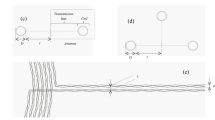Abstract
In this paper, we have developed a load-bearing outer skin for antennas, which is termed a composite smart structure (CSS). The CSS is a multilayer composite sandwich structure in which antenna layers are inserted. A direct-feed stacked patch antenna is considered. A design procedure including the structure design, material selection, and design of antenna elements in order to obtain high electric and mechanical performances is presented. An optimized honeycomb thickness is selected for efficient radiation and impedance characteristics. High gain conditions can be obtained by placing the outer facesheet in the resonance position, which is at about a half wavelength distance from the ground plane. The measured electrical performances show that the CSS has a great bandwidth (over 10%) and a higher gain than an antenna without a facesheet and has excellent mechanical performances, owing to the composite laminates and honeycomb cores. The CSS concept can be extended to give a useful guide for manufacturers of structural body panels and for antenna designers.
Similar content being viewed by others
REFERENCES
A. J. Lockyer, et al., “A qualitative assessment of smart skins and avionics/structures integration,” SPIE Smart Struct. Mater.: Smart Mater., 2189, 172–183 (1994).
A. J. Lockyer, et al., “Design and development of a conformal load-bearing smart-skin antenna: overview of the AFRL smart skin structures technology demonstration (S3TD),” SPIE Smart Struct.Mater.: Industr. Commerc. Applicat. Smart Struct. Technol., 3674, 410–424 (1999).
A. J. Lockyer, et al., “Conformal load-bearing antenna structure (CLAS): Initiative for multiple military and commercial applications,” SPIE Smart Struct. Mater.: Smart Electron. MEMS, 2189, 182–196 (1997).
A. J. Lockyer, et al., “Conformal load-bearing antenna structure,”in: 37th AIAA SDM Conference, Salt Lake City, UT (1996).
http://www.delphi.com, Delphi Fuba Multiple Antenna Reception System.
C. S. You, et al., “Microstrip antenna for SAR application with composite sandwich construction: surface antenna structure demonstration,” J. Compos. Mater., 37,No. 4, 351–364 (2003).
J. H. Jeon, et al., “Design of microstrip antennas with composite laminates considering their structural rigidity,” Mech. Compos. Mater., 38,No. 5, 447–460 (2002).
D. M. Pozar, “Microstrip antennas,” Proc. IEEE, 80,No.1, 79–91 (1992).
D. M. Pozar, “Microstrip antenna aperture coupled to a microstripline,” Electron. Lett., 21,No. 2, 49–50 (1985).
Q. Lee, et al., “Characteristics of a two-layer electromagnetically coupled rectangular patch antenna,” Electron. Lett., 23,No. 20, 1070–1072 (1987).
F. Croq and D. M. Pozar, “Millimeter-wave design of wide-band aperture-coupled stacked microstrip antennas,” IEEE Trans. Antenn. Propagat., 39,No. 12, 1770–1776 (1991).
H. G. Allen, Analysis and Design of Structural Sandwich Panels, Pergamon Press, Oxford (1969), pp. 1–10.
D. Zenkert, An Introduction to Sandwich Construction, EMAS Publ. (1997), pp. 1–10.
X. H. Shen, et al., “Effect of superstrate on radiated field of probe fed microstrip patch antenna,” IEE Proc. Microw. Antenn. Propagat., 148,No. 3, 141–146 (2001).
L. Zhu, et al., “Characterization of microstrip antennas suspended by a dielectric superstrate with high permittivity,” in: Antennas and Propagation Society International Symposium. Vol. 1 (1996), pp. 704–707.
H. Y. Yang and N. G. Alexopoulos, “Gain enhancement methods for printed circuit antennas through multiple superstrates,” IEEE Trans. Antenn. Propagat., 35,No. 7, 860–863 (1987).
D. R. Jackson and N. G. Alexopoulos, “Gain enhancement methods for printed circuit antennas,” IEEE Trans. Antenn. Propagat., 33,No. 9, 976–987 (1985).
X. H. Shen and G. A. E. Vandenbosch, “Aperture field analysis of gain enhancement method for microstrip antennas,” in: 10th IEE Int. Conf. on Antennas and Propagations (1997), pp. 1.186–1.189.
Author information
Authors and Affiliations
Rights and permissions
About this article
Cite this article
You, C.S., Hwang, W. Design and Fabrication of Composite Smart Structures with High Electric and Mechanical Performances for Future Mobile Communication. Mechanics of Composite Materials 40, 237–246 (2004). https://doi.org/10.1023/B:MOCM.0000033266.37171.2a
Issue Date:
DOI: https://doi.org/10.1023/B:MOCM.0000033266.37171.2a




